

 The Accurate Reloading Forums
The Accurate Reloading Forums  THE ACCURATE RELOADING.COM FORUMS
THE ACCURATE RELOADING.COM FORUMS  Guns, Politics, Gunsmithing & Reloading
Guns, Politics, Gunsmithing & Reloading  Gunsmithing
Gunsmithing  FINAL, Test Is Finished! The Effects Of Crown Damage On Accuracy In A Rim Fire Rifle
FINAL, Test Is Finished! The Effects Of Crown Damage On Accuracy In A Rim Fire RifleGo  | New  | Find  | Notify  | Tools  | Reply  |  |
| Administrator |
Gentlemen, As promised, we have taken a brand new BRNO 452 2E 22 rim fire rifle, installed a 6.5-20 X Leupold scope on it, and shot 9 5-shot groups as it came out of the box. The reason for the 9 groups is that we could only fit 9 targets on one piece of paper, and I think this is not going to kake that much of a difference if we had shot 10 groups. As you can see from the close up photo of the crown, it does not look perfect. There are slight dents that are visible in the photo. I will post the groups later on. 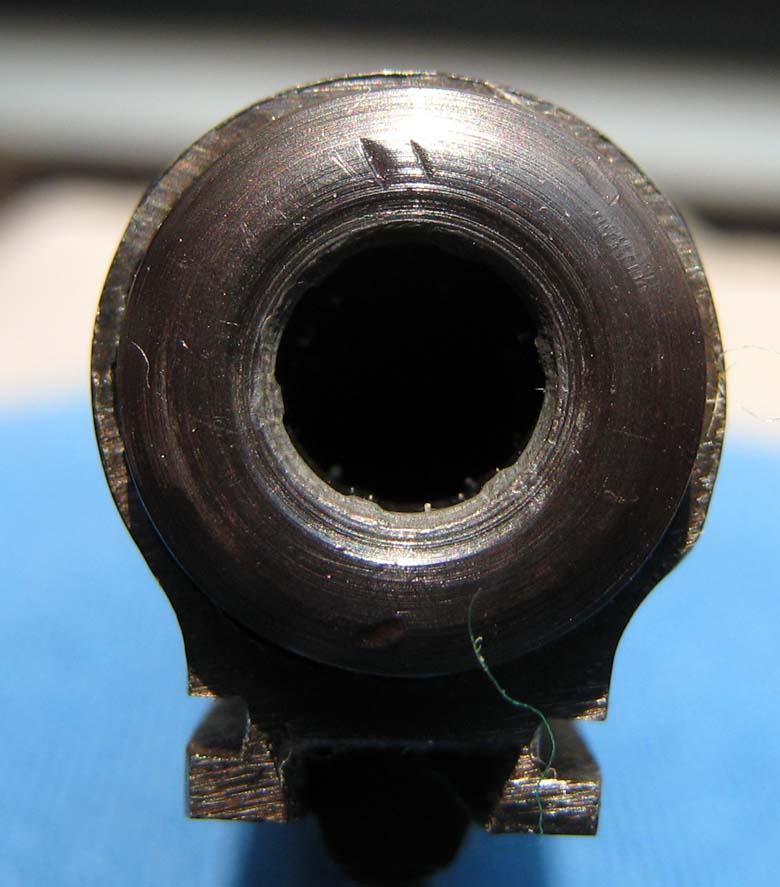 The following photo shows the damage I have done on the crown, using a carbide case trimmer. I am hoping to shoot it tomorrow, and the results will be posted then. After this my plan is to cut the barrel with a hacksaw. Here are the groups of the rifle as it came out of the box: 0.874 0.594 0.742 0.456 0.372 0.686 0.877 0.693 0.340 Average = 0.621 Smallest = 0.340 Largest = 0.877 I put a piece of paper far to the right of the target, and shot a group of 5 shots after that damage we did to the crown. We got a group of 17.300 inches. 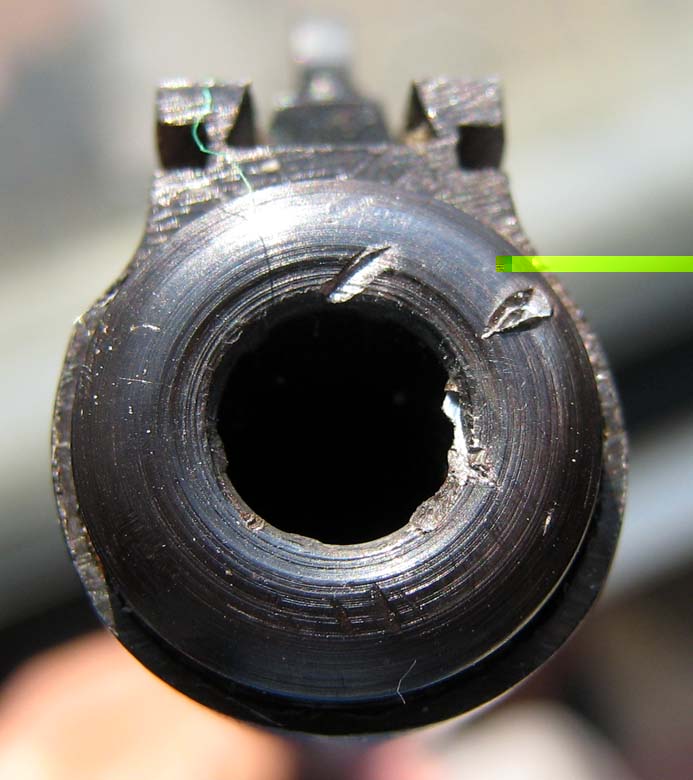 The ammo we are using for this test 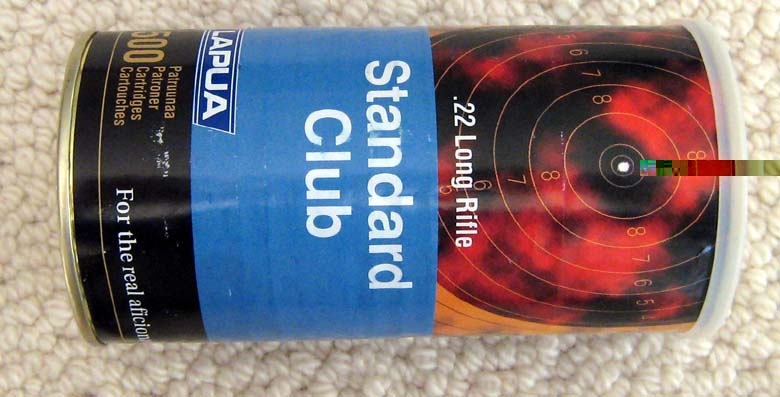 The deburring tool used to clean up the damage. 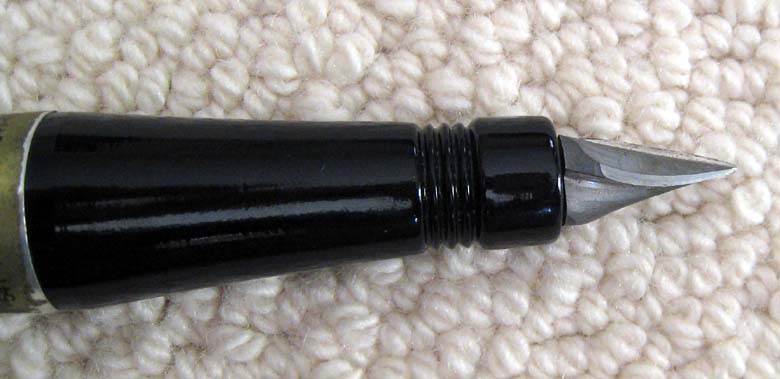 Crown after it was de-burred. We are going to shoot it again as it si now and see what happens. 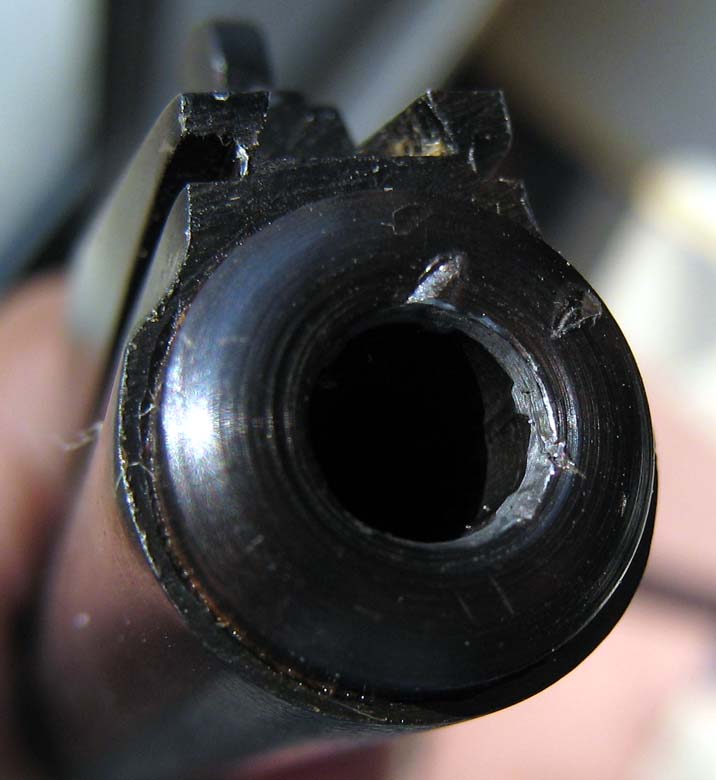 THese are the groups we got after deburring the crown. 0.783 0.593 0.623 0.422 0.417 0.531 0.863 0.981 0.578 Average 0.643 Smallest = 0.417 Largest 0.981 Next we are going to hacksaw the barrel, de-burr it by hand with the above tool, and try agin. 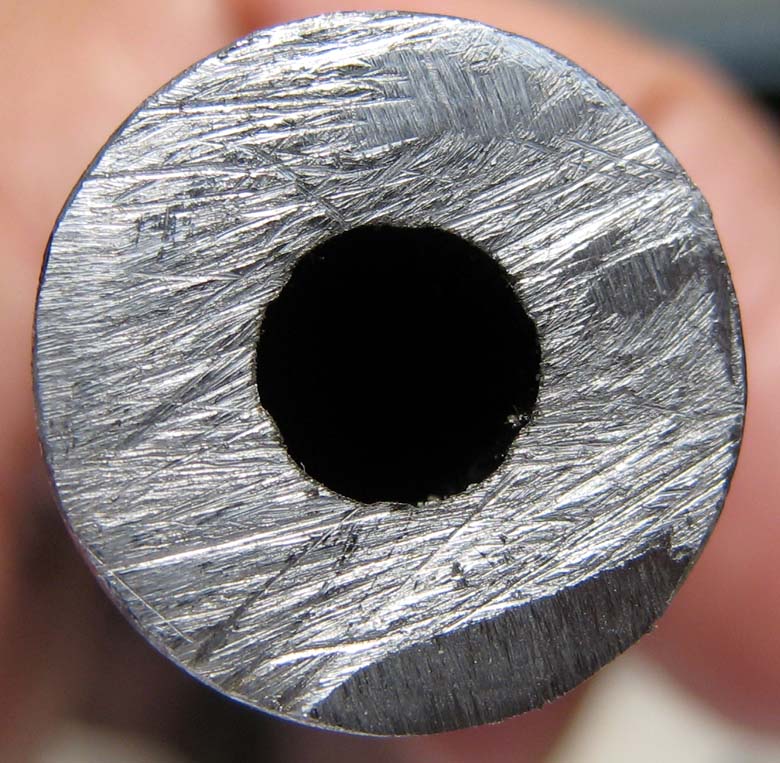 We hacksawed the barrel as you can see, and new groups will be shot as it is now. No attempt will be made to deburr the inside of the barrel. We will deburr it after this lot of groups, and shoot it again. Here the groups we got after the above hacksaw cut. I fired 7 rounds to get the point of aim back on target - it shot about 2 inches low, and 2 inches to the left after the cut. 0.516 0.830 0.525 0.681 0.632 0.407 0.670 0.875 0.347 Average = 0.609 Smallest = 0.347 Largest = 0.875 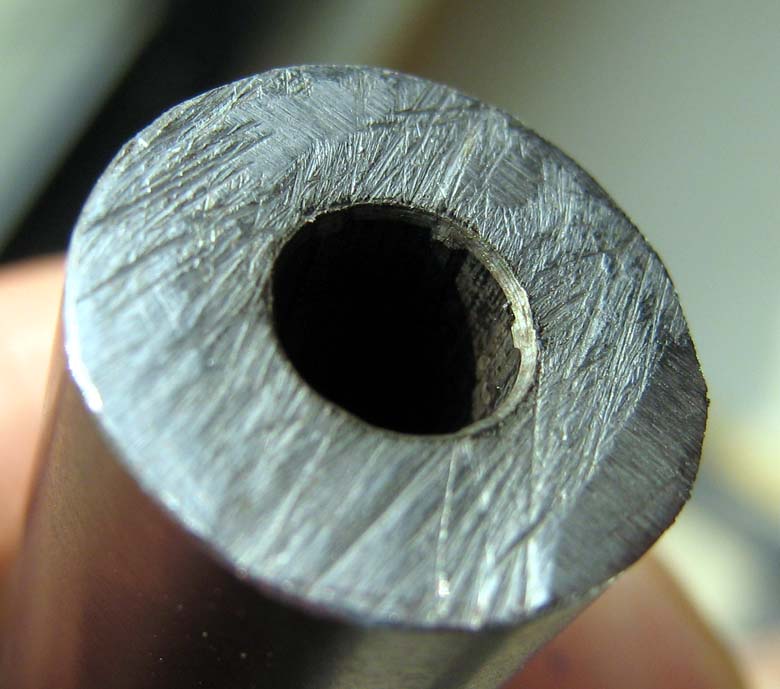 We de-burred the barrel using a hunting knife, and shot the following groups. 0.949 0.661 0.730 0.289 0.876 0.370 0.261 0.553 0.896 Average = 0.620 Smallest = 0.261 Largest = 0.949 More damage will be inflicted, and the test will continue.  A Wilson case mouth de-burring tool was hammered into the barrel, the results of which are as you see below. 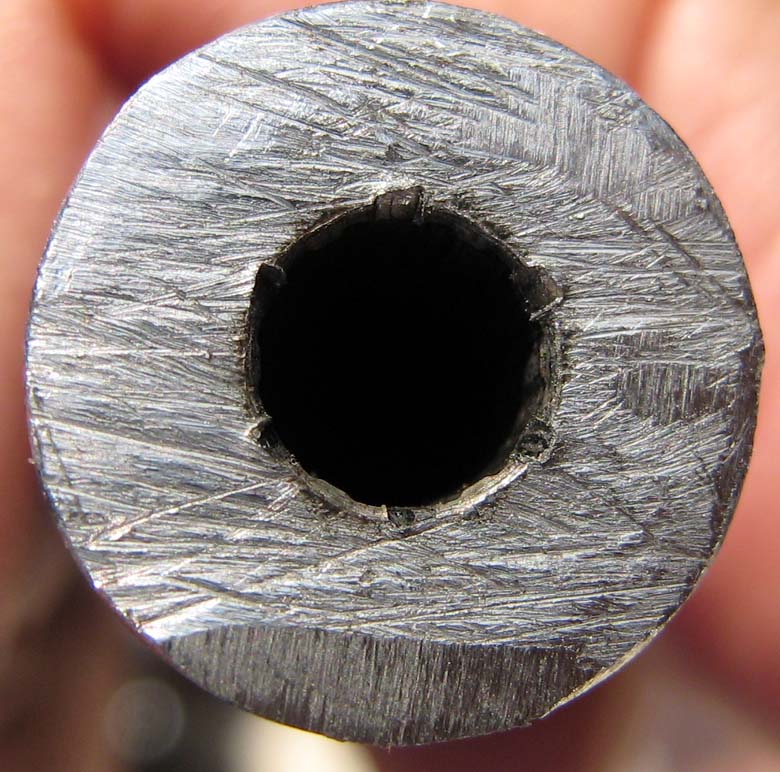 We will see what results we get from it now. Here is the result after the above damage was done. 1.049 0.916 0.368 1.072 1.084 0.755 0.844 0.772 0.525 Average = 0.820 Smallest = 0.368 Largest = 1.084 We made a 90 degree cut across the muzzle, and removed the burrs, as you can see below, then fired the final grounps. 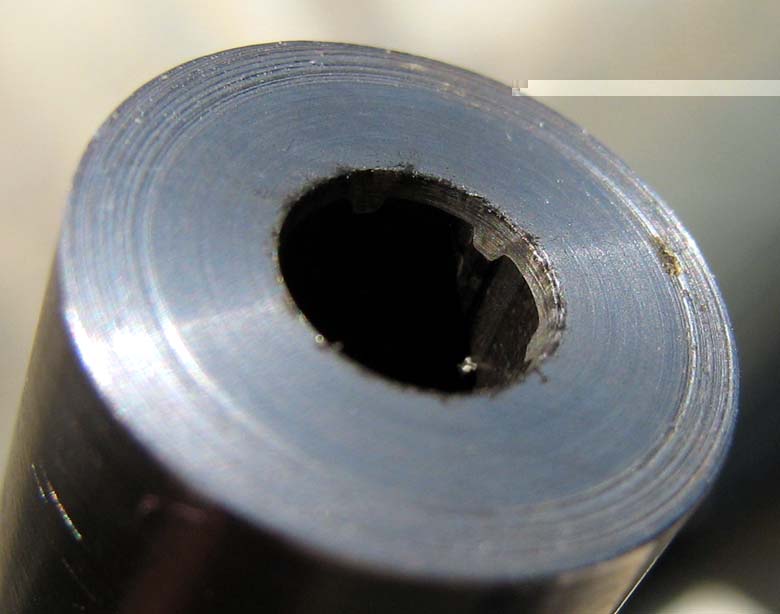 0.413 0.719 0.349 0.376 0.302 0.440 0.320 0.290 0.608 Averager = 424 Smallest = 0.290 Largest = 0.608 WE are considering running a similar test with a 308 Winchester rifle. I will let you know once we find a suitable candidate. | ||
|
| One of Us |
Saeed, Take all safety percations shooting the "damaged" crown. Those gouges could behave as a bore constriction. Buliwyf | |||
|
One of Us |
thanks for this research...the photos are a real help to visualize the dameged crown. That's a fine camera ya got there! /////////////////////////////////////////////////////////////////////////// "Socialism is a philosophy of failure, the creed of ignorance, and the gospel of envy, its inherent virtue is the equal sharing of misery." Winston Churchill | |||
|
| Administrator |
I took the photos above with a small pocket camera. The Canon Ixus 850IS. It is 7.1 MB camera, with an image stabilizer. It is the same camera I had with me in Africa a few months ago. In addition to taking very good quality photos, it also takes very good quality video. And if one has a large enough memory card - the maximum it will take is 8 GB - one can take over an hour of vifeo that is better than VHS! Amazing really considering its size. We also got a new bore scope attachement that connects to a video monitor. And boy does it ever open one's eyes to look at factory rifles with it! It is so much easier to see manufacturing marks, rust pits and any other damage inside the bore using this attachement than just looking through the borescope with the naked eye. The machining marks inside the barrels of soem rifles look just like what you see on the outside of that muzzle above. | |||
|
| one of us |
I have a couple of Everest Imaging borescopes at work and it's amazing what the inside of barrels look like. I'd post pictures but I'm afraid to ask my technicians to teach me how the image capturing and measurement functions work because they'll quickly figure out what I want to use it for. Frank "I don't know what there is about buffalo that frightens me so.....He looks like he hates you personally. He looks like you owe him money." - Robert Ruark, Horn of the Hunter, 1953 NRA Life, SAF Life, CRPA Life, DRSS lite | |||
|
| one of us |
Saeed I just got a Conon 710IS to use when I don't feel like Carrying my Rebel XT with the extra lens around. That little Canon 710 IS is a awesome camera as I am certain the 850IS is also.  Doug Humbarger NRA Life member Tonkin Gulf Yacht Club 72'73. Yankee Station Try to look unimportant. Your enemy might be low on ammo. | |||
|
| One of Us |
My caution to new shooters is forget the chronograph and don't look down your barrel with a bore scope! The only easy day is yesterday! | |||
|
| One of Us |
Before you get too excited, worried or draw hard conclusions on what you are seeing in rifle bores with a magnified video scope take a look at a magnified picture of the edge of a razor blade sometime. Or, more appropriate for your tests, take a look at a brand new custom made barrel and then make comparisons. This is sort of like my earlier suggestion that you start your tests with a known entity (a new barrel with a concentric and properly executed crown). Unless you have something with a known value attached to it it’s really difficult to draw meaningful conclusions from your test data. I was only partially joking when I posed the possibility that the damage inflicted might actually be correcting for a poorly done crown. Anyway, it’s your time,money and test so who the Hell am I to be telling you how to do it! | |||
|
| Administrator |
Well, a REAL monkey wrench was thrown into the equation! As you can see from the damage on the muzzle, it is on the left hand side of the barrel. First shot out landed about 3.5 feet to the RIGHT of the point of aim! I could not get the scope to adjusted to the point of aim with the adjustment turned all the way to the left. I will use a deburring tool to remove the bur, and see what results we get. | |||
|
| one of us |
use a bigger target in times when one needs a rifle, he tends to need it very badly.....PHC | |||
|
| one of us |
move your existing targets closer to the rifle muzzle? Jamie | |||
|
| One of Us |
One would figure that the POI would move with that amount of damage, but do you think the groups, even though they were impacting some 3.5 feet to the right, were as tight as before the damage? | |||
|
| One of Us |
Take a look at the Lilja website. They have a video scope comparison of a new Rem 700 barrel and a Lilja barrel. It's pretty amazing. You have to kinda look closely to see that they are moving the scope in the Lilja barrel. | |||
|
Moderator |
It's nice to see the AR wrecking crew back in action  __________________________________________________ The AR series of rounds, ridding the world of 7mm rem mags, one gun at a time. | |||
|
| one of us |
Don't get too excited about magnification. If you have access to a zoom microscope try going from 7X to 40x while looking under your finger nail. Even the bearing surface of an orthopedic knee or hip replacement implant looks like a wash board and they are polished to a 4RA finish after machining or grinding. If you have gas springs on your car to prop up the hood or the trunk lid take a look at the finish on the ground shaft. It is normally a 3 RA. Then drag you finger nail down it to check it out. | |||
|
| One of Us |
It would be interesting to hear some comments from the people who said that crown condition doesn’t effect accuracy to any measurable degree, explaining what they believe caused the bullet to strike 3.5 feet[!] from the POA. | |||
|
| One of Us |
I think that they are going to see how it groups. I know a damaged crown will change the POI, but how much effect will it have on grouping ability. Butch | |||
|
| one of us |
Having a large burr poking into the bore area will cause bullet deformation/damage. That's not really within what this test seems intended to check, and I personally don't put any stock into the large change in POI. The controversy seemed to me to be more about the effects of an uneven crown from poor crowning or cleaning rod wear. Believe nothing, no matter where you read it, or who said it, unless it agrees with your own reason and your own common sense. | |||
|
| One of Us |
I understand that, but the whole topic raises some interesting questions. Some people have stated categorically that the condition of the crown/muzzle makes no measurable difference for a “hunting rifle.†I’m sorry,but I would consider throwing the bullet three and half feet from the point of aim to be a fairly good sized “measurable difference“ unless you’re relying on possibly scaring the animal to death with the noise. | |||
|
| One of Us |
fyj, I am very anal about my crowns. I recrown after every 3 BR matches. Yes if you damage it in the field you might miss your animal. I believe that a properly cut crown at any angle will group. Fjy, I'm not disagreeing with you. Butch | |||
|
| One of Us |
Butch, I too am very picky about my barrels,their installation and condition, since they are what start the bullet on the intended path to the target. I just found it interesting that something that moves a bullet three and half feet on target can be viewed by anyone as something that has no measurable or significant effect. | |||
|
| One of Us |
Saeed I think that is very very useful informaion, Thank you. I look forward to your next observations with the shorter barrel and angled crown. I also think it might be more clear if you used a strict definition of the terms Accuracy and Precision. Clearly putting a large divit in the crown changed the point of impact(POI) or the accuracy of your rifle. Did it also change the precision (enlarge the group size)? I think you probably did not measure the group because the POI had moved off the paper. With the crown deburred, the precision changed with the groups enlarging ~.022 from .621 to .643 (I assume inches at 50 yards for .22 cal). If this were translated to a hunting situation, that change would be ~ .04 minutes, most shooters would not consider this significant for a "hunting" rifle. Check here for one definition of the terms precision and accuracy. http://en.wikipedia.org/wiki/Accuracy Roger | |||
|
| One of Us |
Roger, I totally agree with you on the difference between accuracy and precision, which is why in my opinion hunting rifles need to have as little variation in POA and POI (accuracy) as is mechanically and humanly possible. I believe if you took a survey of barrel makers,competitive shooters, ammunition manufacturers,ballistics experts, and professors of physics, that you would be hard pressed to find many that would argue against a muzzle crown being cut concentric, symmetrical, perpendicular to the axis of the bore, and free of dings, dents and other roughness. Not one of those professions, that I am aware of, has ulterior motives that would unduly influence their views on muzzle crowns. Which type or style is pretty much up to personal taste as long as those aforementioned requirements are met. | |||
|
| One of Us |
Saeed Thanks for the update. I am not great with statistics, but I wonder if a formal analysis would show the differences to be statstically insignificant. There is a much larger difference in the 9 group sizes in each set than in the average differences between sets. Also thanks for posting the size of the group with the large divit; 17.3 inches is a cluster not a group! In the future I will look for some other cause if a 1 inch rifle suddenly shoots a 5 inch group and the crown has no obvious divit. If I am hunting and a rifle does get crown damage, I feel more comfortable deburring and resetting the scope until it can be recrowned properly. Perhaps those hunting in the west taking several hundred yard shots feel differently, but for whitetails in timber at 25-75 yards, mild crown damage should not put a rifle out of service. FYJ I'm sorry, you lost me. I don't find any one suggesting a crown should not be constructed with generally accepted practice. I don't know how or why anyone would machine a crown in any other way! The question was what effect does damage to a crown have on impact point and group spread. Excluding an obstructed bore that threw shots "far" to the right with a 17.3 inch group, the non-concentric but deburred muzzle seems to show a change of impact point but a smaller group. I think Saeed is to be commended. His data shed light, not heat on the question. Rather than opinion we have experiment. It may be difficult to explain or even hard for some to accept; but the number, size and consistancy of his groups has me convinced. Thanks again Saeed Roger | |||
|
| One of Us |
Roger, I guess maybe you haven’t read all the posts and opinions that have been expressed on the several threads dealing with this topic. There have been more than a few that have suggested that the condition of the muzzle/crown has little or no measurable effect on either accuracy or precision, and have suggested that it is nothing more than an old wives tale being perpetuated by gunsmiths trying to charge for work that isn’t really necessary on a hunting rifle. | |||
|
| Administrator |
Gentlemen, I think we need to bear in mind that we are talking about HUNTING accuracy. And what one MIGHT do if the crown gets damaged in the field, and one has to do some field repair. In fact, this has given me an idea. I will put another dent in this muzzle, then "repair" it with a knife, just as one might do while hunting, and see what results we get. | |||
|
| One of Us |
Hmmmm, the groups are improving. So it is safe to assume the barrel is breaking in nicely. | |||
|
| One of Us |
Great data, Saeed, and plenty of it. I have a couple of cheap 22's that I shortened with a hacksaw and file. They shoot great. Dr. Mann did a similar test over 100 years ago and found no change in group size, only a change in POI, though perhaps he did not mangle the crown as severely as you did. Plus, he was shooting long Pope-style bullets. | |||
|
| One of Us |
interesting stuff--chris | |||
|
| One of Us |
Certainly these results are counter-intuitive at the least, and to me, anyway, very surprising. Thanks for conducting these interesting experiments and posting the results. Mike Wilderness is my cathedral, and hunting is my prayer. | |||
|
one of us |
That thing is shooting even better now Saeed. We should all cut off our 22 barrels and deburr w/ pocket knife It is intresting that the accuracy is increasing w/ the hacksaw cut and deburring job w/ a pocket knife. Looks like that throws out some of the crown myths that have been floating around. It would be instresting to see this same experiment with a cart of a little more speed, say a 223.... Have a Good One Reloader | |||
|
| Administrator |
Gentlemen, May be some of our more brainy members might enlighten us on statistics. Let us assume we have 100 rounds we wish to use to test for accuracy. Which of the following would give us a better answer statically? 1 100 round group 2 50 round groups 4 25 round groups 10 10 round groups 20 5 round groups 100 1 round groups | |||
|
| one of us |
If I thought you were really interested in the answer, I could tell you. But you only have to look back to the .22 testing thread to find it anyway. Brent When there is lead in the air, there is hope in my heart -- MWH ~1996 | |||
|
one of us |
I appreciate the testing and it does pose some serious thinking on the matter, but I would like to see something with more pressure that I think would have a bigger effect on the bullet. Let's say 30-06 class or any decent-size centerfire, producing more pressure and gases, that would put this whole "test" to the test, so to speak. I can't help but think that if the pressure increases, the amount bullet deflection will increase as well. Also, testing group size between boat tails and non-boat tails to see what the effects would be there too. Thanks for the testing just the same Saeed.....It is interesting. Williams Machine Works  | |||
|
| One of Us |
Saeed I am not a statistition, but it seems to me that if you are defining "accuracy" as the ability to put a hole at the point of aim, the differences between those options will be practical, not statistical. They are all equal from a purely mathematical perspective. The most easily measured would be 100 groups of one shot. Jut measure the distance from the x to the center of the hole. The other extreeme would be difficult to measure, You would have just one large ragged hole. In any case in between, there is no difference to the numbers. A different question is how many shots does it take to reasonably determine the usual limits of variation for any barrel. I am sure someone has worked that out in the past and will explain this for all of us. Roger | |||
|
| one of us |
the most remarkable groups i've witnessed so far were from factory rifles. | |||
|
| One of Us |
20 5 round groups with a complete cleaning between each group. | |||
|
| one of us |
Not sure how to approach this, and am not especially brainy anyhow, but in general I try to get 20 samples of something before trying to calculate standard deviation ( rule of thumb ). There are other influences at work, barrel heating and the effects of clean/dirty barrel conditions being the first that come to mind. Those influences need to be considered when planning the sequence and timing of shots. A three-shot group is sort of traditional, to triangulate a point of aim with a minimum cost, a five-shot group seems to be favored to get a little more detail and examine the effect of barrel heating, but to get statistics with a reasonable confidence interval more shots are indicated unless the number of shots is spread over a change in conditions. I am assuming that wind is being accounted for in some manner, a la the Houston Warehouse... TomP Our country, right or wrong. When right, to be kept right, when wrong to be put right. Carl Schurz (1829 - 1906) | |||
|
| Administrator |
All shooting is done in an undeground shooting tunnel, so wind does not have any effect. | |||
|
| One of Us |
Even if there is a blowhard present? | |||
|
| Powered by Social Strata | Page 1 2 |
| Please Wait. Your request is being processed... |
|
 The Accurate Reloading Forums
The Accurate Reloading Forums  THE ACCURATE RELOADING.COM FORUMS
THE ACCURATE RELOADING.COM FORUMS  Guns, Politics, Gunsmithing & Reloading
Guns, Politics, Gunsmithing & Reloading  Gunsmithing
Gunsmithing  FINAL, Test Is Finished! The Effects Of Crown Damage On Accuracy In A Rim Fire Rifle
FINAL, Test Is Finished! The Effects Of Crown Damage On Accuracy In A Rim Fire Rifle

Visit our on-line store for AR Memorabilia

